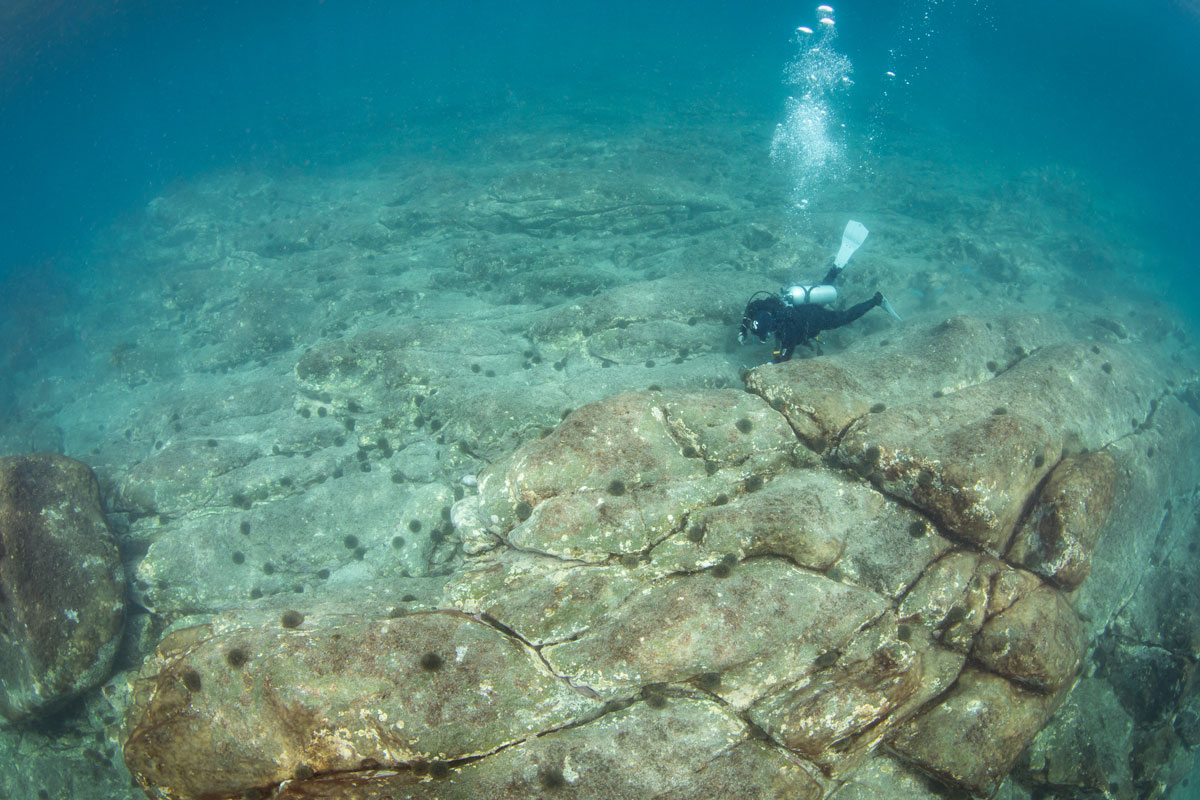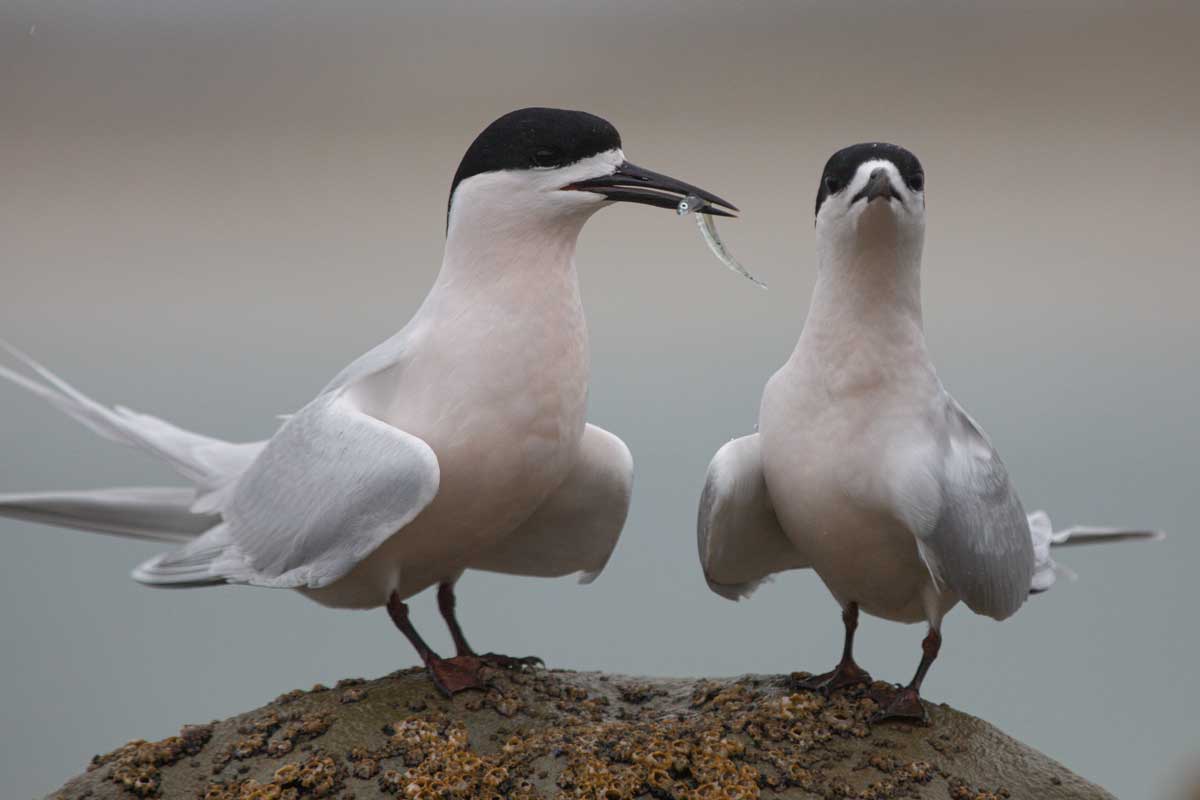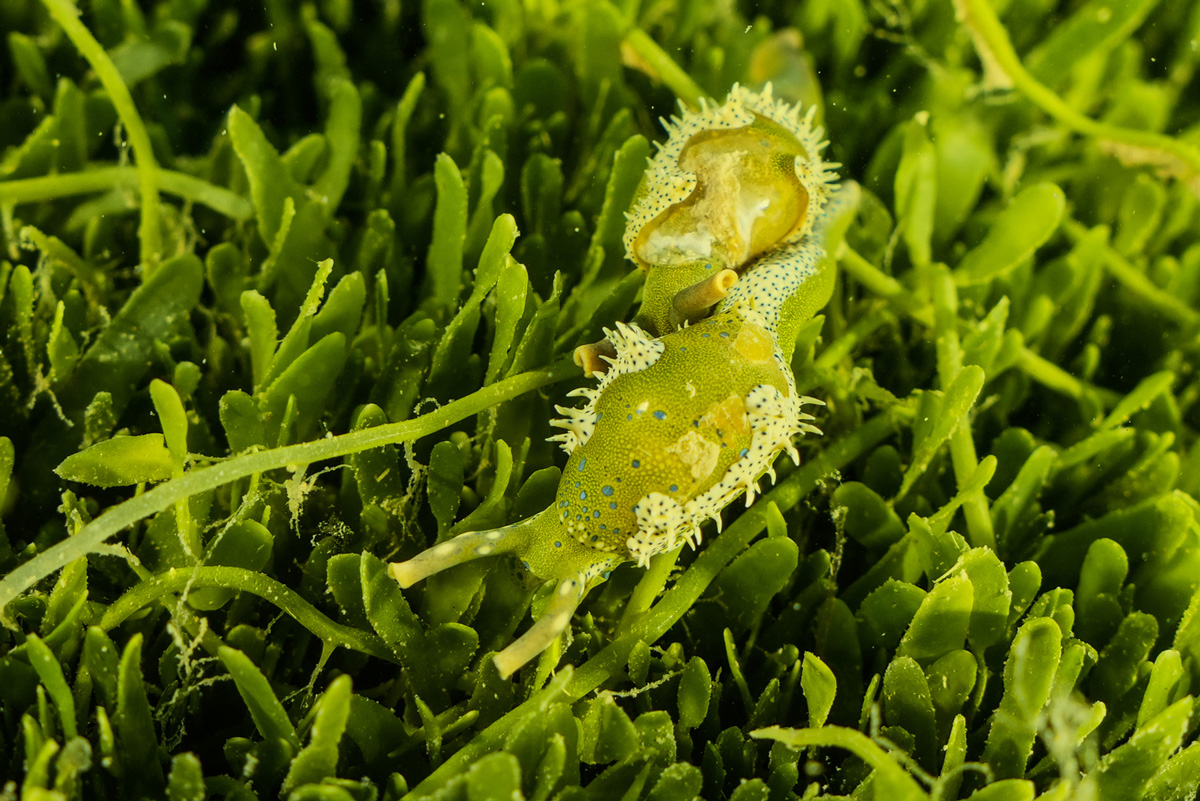We all love our Hauraki Gulf/Tīkapa Moana/Te Moananui-ā-Toi, and the will and increasing efforts of people to restore and improve its ecological health are encouraging. Places like Goat Island Marine Reserve (Te Hāwere-a-Maki) let us experience what our Gulf’s rocky reefs can be, with lush kelp and thriving marine life. Sadly, this is now the exception, not the norm, and our marine environment needs help.
Over the last decade, there has been an increasing awareness of the extent and consequences of kina (sea urchin) barrens within the Hauraki Gulf and other parts of Aotearoa. Many of us want to see these “marine deserts” restored back to kelp forests that once existed across the Gulf and over the past four years we have been researching potential restoration tools to address kina barrens.
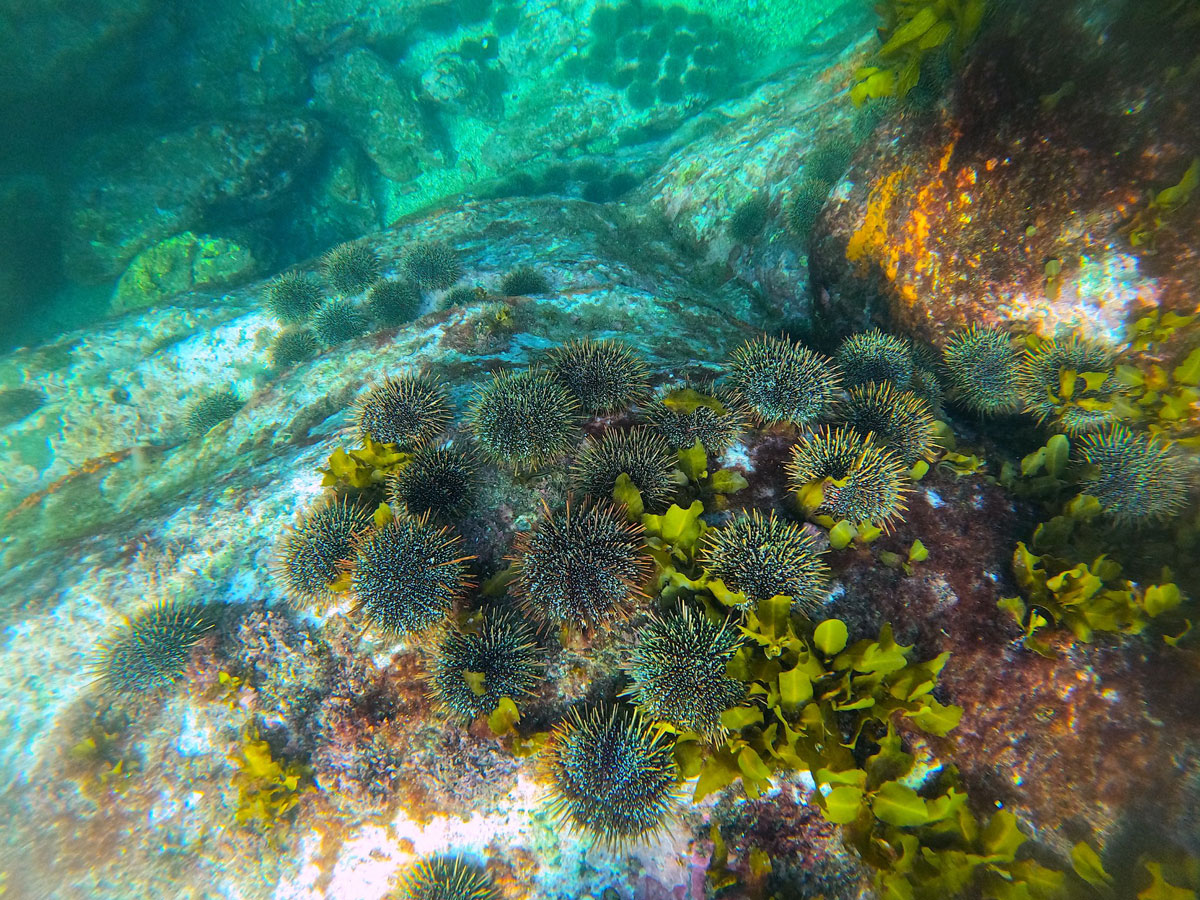
What are kina barrens, and why are they an issue? Kina barrens are deforested areas of reef where the common sea urchin Evechinus chloroticus or kina have eaten all the kelp, and their continued grazing prevents kelp from growing back. These reefs have less habitat for other species, lower biodiversity and reduced productivity. The increase in kina that has led to kelp forest loss has occurred following a long history of human harvest of their main predators – tāmure (snapper) and kōura (crayfish). These historically important predators are now substantially reduced in size and abundance, and no longer play a key role in keeping kina numbers in check. Consequently, kina barrens are a tohu or indicator of a reef ecosystem that is out of balance.
We know that these ecosystems can be restored to lush kelp forests – we’ve seen it happen. In Cape Rodney-Okakari Point (Te Hāwere-a-Maki, Goat Island) and Tāwharanui marine reserves, protection of key predators allowed kina barrens to return to kelp forests naturally over time via trophic cascades (Babcock et al., 1999; Shears & Babcock, 2002). However, marine protected areas are a small portion of our waters (less than 0.3%), and recovery times are slow; it takes >15 years for these processes to occur. Active restoration through kina removal can potentially be used to be used to speed up kelp recovery and there is growing interest from community groups and fisheries managers to actively remove kina as part of kelp restoration. However, understanding when, where and how kina removal can be a used as part of kelp restoration plans is essential to guide restoration efforts and management of kina barrens.
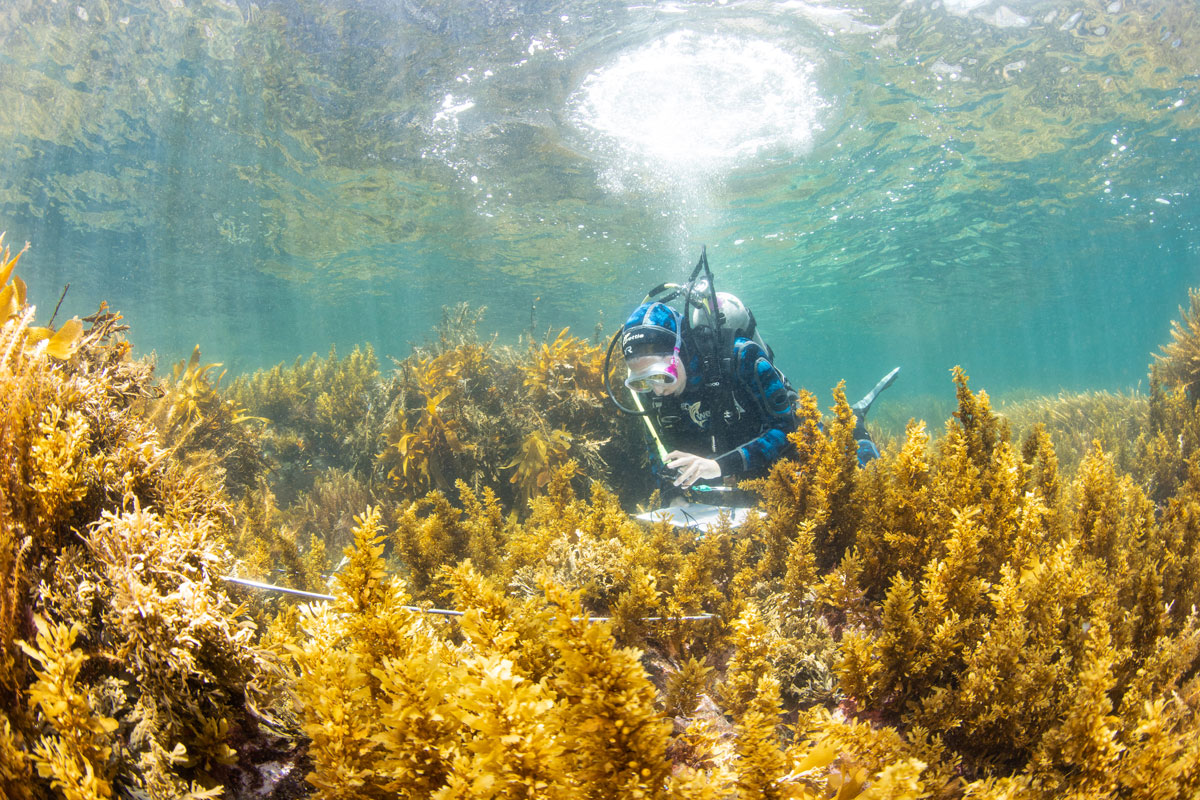
Over the last four years we have been undertaking research to evaluate the potential role and effectiveness of kina removal as a tool for kelp forest restoration and addressing the kina barren problem. Our goal is to understand the practicality, feasibility, and ecological effectiveness of kina removal through various methods. With support and partnership with Ngati Manuhiri and Ngai Tai ki Tamiki, we obtained an MPI Special Research Permit to remove kina from large areas (1.6-2 ha) of kina barrens at 4 sites, from Ōtata – Noises to Hauturu-o-Toi – Little Barrier Island (photo). Kina were removed in summer 2020/2021 and we have since monitored kelp recovery, kina density, behaviour and roe quality, and fish and crayfish densities within these areas over 3 years in comparison to surrounding kina barrens.

Considering the current and increasing interest in removing kina from barrens as a way of restoring kelp forests, we want to share some of our learnings to help guide kelp restoration initiatives, but also provide clarity on what sea urchin removal does and does not achieve. We aim to provide scientific guidance to help stakeholders decide if kina removal can be a useful tool for kelp restoration; and if it is to be used, how to improve the success of restoration projects.
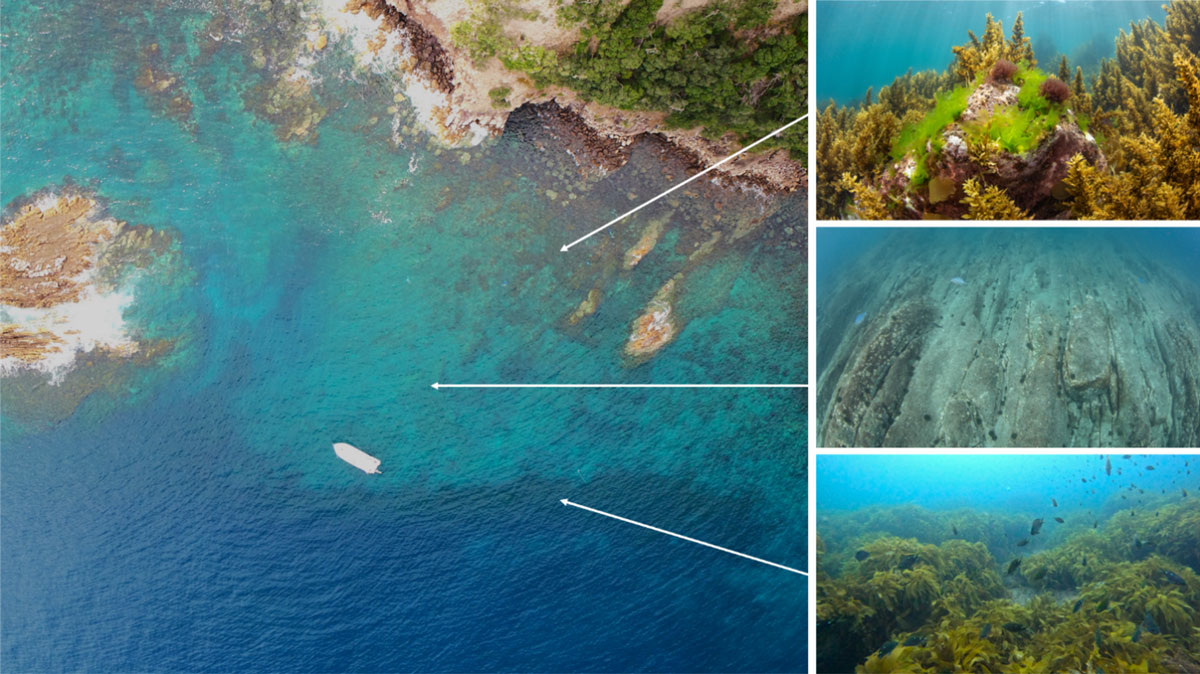
1) Kelp restoration must first address the cause of kelp loss.
Our findings apply where kina are the main drivers of kelp loss and form kina barrens. In other parts of the country, sediment runoff and climate change may also cause kelp loss so other measures are needed to promote kelp restoration. However, where kina are the cause of the kelp loss and form kina barrens, there will be no kelp recovery unless their overpopulation is addressed (e.g. transplanting kelp into barrens won’t help).
2) Does kina removal from barrens lead to kelp recovery?
Yes. Kina removal from barrens, when conducted systematically and thoroughly at large scales (see below), can be very effective at letting kelp recover naturally. Across our four experimental sites the removal of ~90% of all kina led to rapid kelp recovery – the rate of recovery and range of seaweed species recovering in the removal areas was faster and greater than anticipated (photos). In just two years, average kelp cover increased from 5% to 43% with approximately 3.5 million new kelp plants (Miller et al., 2024). We saw multiple species of kelp and seaweeds reseeding naturally into the removal areas within one year without the need kelp transplanting or “reseeding”. These high rates of natural recovery can likely be attributed to the shallow band of seaweeds and deeper kelp forest at each site providing spores (seeds) to replenish the previously barren areas. In areas where remaining seaweeds are lacking, additional enhancement and reseeding may help accelerate recovery.
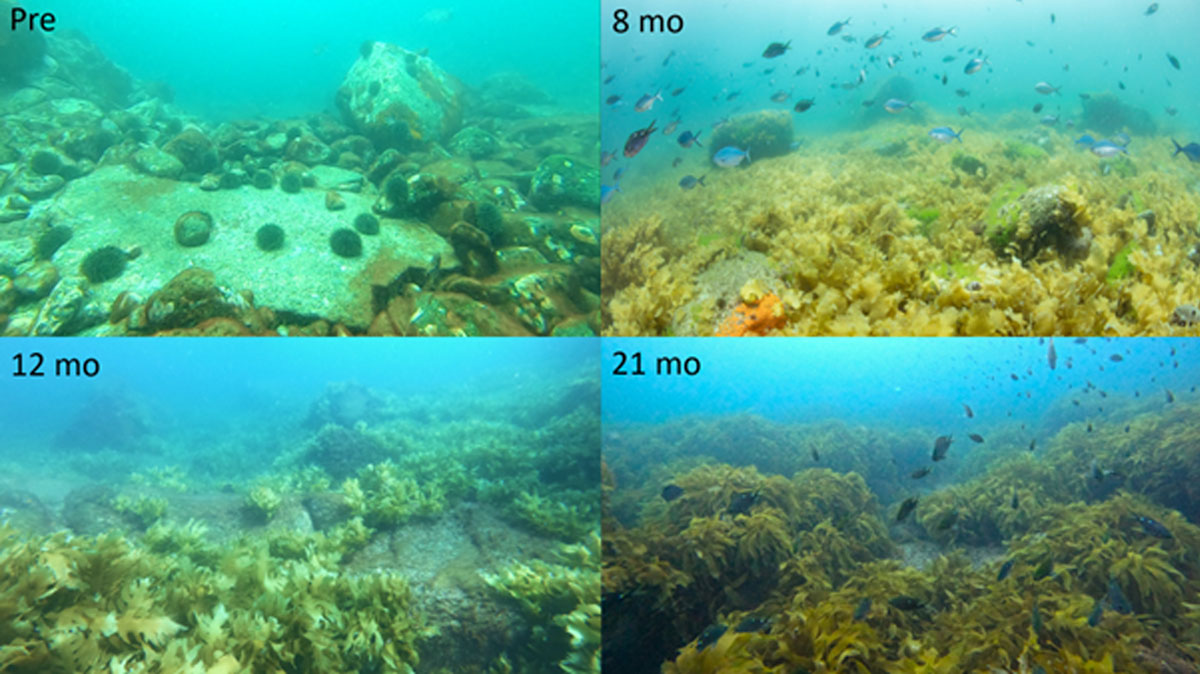
3) Does kina removal lead to kelp forest restoration?
No. While we saw rapid recovery of kelp, after three years, kina are now returning into the cleared areas and we are starting to see kina grazing kelp. This is because removing kina does not address the underlying cause of kina overpopulation – there is nothing to prevent kina from increasing as natural predator abundance remains low in these areas due to fishing. We did not see any increase in important reef predators (kaimoana) such as snapper and crayfish following urchin removal as these areas remain open to fishing. We observed, on numerous occasions, recreational and commercial fishing occurring within these sites. In the Hauraki Gulf, and most parts of the world, overpopulation of sea urchins represents an ecosystem out of balance due to historic and ongoing overfishing of predators.
Kina removal is treating a symptom, not fixing the cause. If the restoration goal is simply to increase the amount of kelp, then kina removal works in the short-term and kelp will remain as long as kina removal continues. While increases in kelp will increase biodiversity, productivity, and even benefit kina roe quality, it is important to recognise that these benefits of kina removal will only be temporary without a long-term plan.
In contrast, if the goal is to restore a fully functioning kelp forest ecosystem, then kina removal can jump start restoration, but needs to be carried out in combination with other measures like marine protection that restores natural predators of kina. This would provide a more holistic and long-term plan for kelp forest restoration.
How to carry out/use active kina removal for kelp restoration?
If you intend to use kina removal as part of a kelp forest restoration plan, you need to be clear on your goals, and plan properly to improve chances of success. We are working on a more thorough guide for kina barren restoration, but the key points are:
- Define goals. Restoration plans need to be clear as to what they want to achieve (e.g. kelp recovery or full ecosystem restoration?). This will help to determine the methods used and in evaluating restoration success.
- Permissions. Kina are managed under the QMS and are an important kaimoana species. Therefore, removals require special permits and consultation with local hapu and iwi.
- Site selection. Removal from large (>1 ha) discrete areas of barrens (e.g. bays or bounded by sand) will generally be most effective at promoting kelp recovery as it minimises the rate of kina reinvasion into removal areas. If kina are only cleared from small or partial areas of barrens they will quickly reinvade from surrounding barrens and therefore will need continued removal every couple of weeks or months; reinvasion also limits kelp recovery. The larger the area cleared, the longer it will take for kina to return – the 1-2 ha areas in our study had limited kina return after 3 years. Removal sites should be clearly identified (e.g. rock pinnacles, discrete bays and/or have boundaries marked with leadline or chain).
- Reduce kina below critical density. Urchin densities need to be reduced below 1 kina/m2 to ensure kelp has the potential to regrow. Research shows that removing only a small proportion of kina or not removing systematically will not have any benefit. Lots of kina are needed to create a kina barren, but only a few kina are needed to maintain a barren as only a few kina are needed to graze down any juvenile kelp plants that sprout.
- Removal method. For the purposes of our experiments, most of the urchins were culled in place by trained SCUBA divers as this was the most efficient method to undertake the research on the required scales and time frames. Some urchins were initially harvested for local hapu, but the roe quality of kina in the barrens was not desirable. Different methods may be possible in different situations (e.g. efficiency, quality of kina).
- Culling – This is the most commonly used method worldwide, as it is the most efficient and least resource intensive method which allows larger areas to be cleared more efficiently, increasing the chances of success (Miller et al., 2022). While culling may be considered wasteful, in many cases kina are not harvestable for kai and culling means the nutrients are recycled into the marine system. To reduce kina densities below the critical threshold of 1 per m2 takes approximately 50 diver hours (culling on SCUBA) per hectare of barren reef or double this if freediving or collecting kina (Miller & Shears, 2023).
- Harvest for consumption – While kina in barrens may be lower quality, sometimes kina in barrens may have good enough roe for harvest, especially in spring-summer. Therefore, harvesting at least a portion of kina may be possible. While commercial harvesters are much faster than the average person, it would be necessary to incentivise systematically removing all kina rather than harvesting only a portion of the kina. Without a systematic removal, kina densities will likely not be sufficiently low to allow kelp to regrow.
- Harvest for roe enhancement – Methods that harvest poorer quality kina from barrens and enhance the roe in seawater facilities (e.g. kina-nomics) or through translocation may also be an option. However, this approach is highly resource intensive and as with harvest, kina densities must be reduced sufficiently over large areas to ensure success. It is unknown whether such approaches can be cost-effective and carried out at scales relevant for restoration.
- Monitoring. To know if the restoration plan is working, monitoring is needed to know if kina densities are sufficiently low and if kelp is growing back.
- Long-term plan. Kina removal is only a temporary fix on its own, so removal efforts need to be part of a long-term plan – either address the predator problem or plan to continue to remove kina.
Restoration projects may include multiple removal methods (Lee et al., 2021). We recommend that kina from barrens be harvested and utilised where possible, but where kina barrens are extensive culling will likely be required to ensure enough urchins are removed to guarantee success. Culling is only recommended as a one-off approach to reset the system and allow kelp to recover; subsequent removals can use harvest as kina in removal areas have greater roe quality.
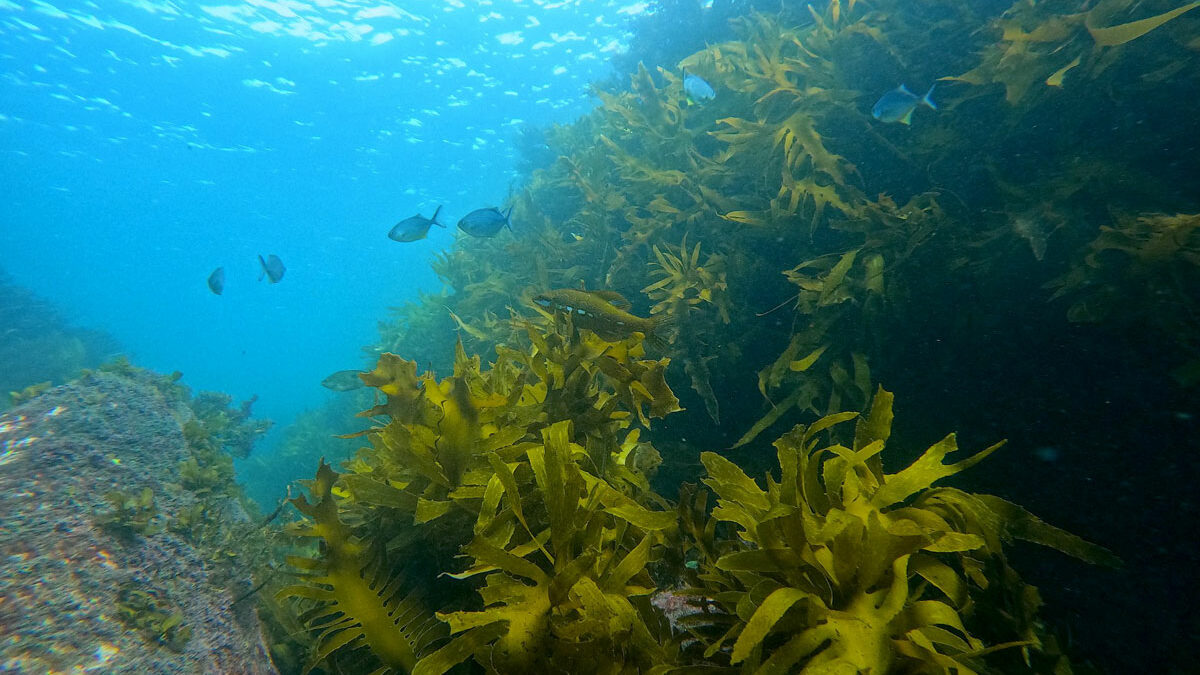
While many of us who spend time in the water are eager to restore the beloved forests of the sea, we need to be clear on what we are trying to accomplish. Our results clearly show that removing kina can restore kelp into kina barrens, but this is only a temporary “fix” on its own. The results are also very encouraging as they show that the environmental conditions in the Gulf can still support productive kelp forests. However, we want to caution against trying to “solve” the kina barren problem across large areas through simply removing urchins. While this may bring back kelp it does not address the underlying problem and restore a healthy and resilient kelp forest ecosystem. It simply “brings back the trees without the birds”. While removing kina can kickstart kelp recovery on small scales, we need the large predators that once roamed the reefs to fully restore kelp forest ecosystems. Increased protection, such as the proposed High Protection Areas as part of Tai Timu Tai Pari – The Hauraki Gulf Marine Spatial Plan is a start to restore the diverse kelp forest ecosystems and the diversity of life within them that once occurred in this area. In addition to large ecosystem-based management approaches, locally led collaborative protection and restoration are also needed for regeneration of our Gulf.
LINKS TO RESEARCH:
Sea Urchin Removal as a Tool for Macroalgal Restoration: A Review on Removing “the Spiny Enemies”
The efficiency and effectiveness of different sea urchin removal methods for kelp forest restoration
Large-scale one-off sea urchin removal promotes rapid kelp recovery in urchin barrens
Acknowledgements:
Many thanks to Ngāti Manuhiri and Ngāi Tai ki Tāmaki for their support and partnership through this project. Many thanks to the staff and students at the Leigh Marine Lab and collaborators, without whom this project would not have been possible, in particular: Celia Balemi, Caitlin Blain, Paul Caiger, Sara Kulins, Ohad Peleg, and Arie Spyksma. The research is funded by Foundation North’s Gulf Innovation Fund Together (G.I.F.T) and Live Ocean and Sustainable Seas. Follow us at @nzreefs


